Types of connectives
Download as PPT, PDF9 likes14,988 views
This document discusses different types of connectives that can be used when writing sentences: adding connectives to join agreeing ideas, sequencing connectives to list ideas in order, emphasizing connectives to stress an important point, comparing connectives to show similarities, cause and effect connectives to explain one idea with another, qualifying connectives to condition one idea on another, illustrating connectives to provide examples, and contrasting connectives to show opposing ideas. Examples are provided for each type of connective.
1 of 8
Downloaded 336 times
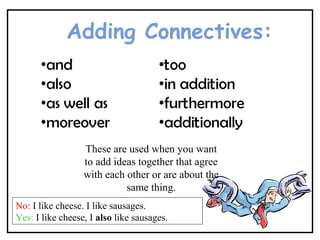
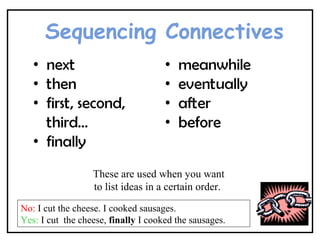

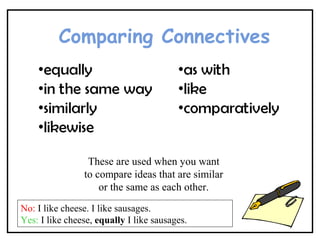


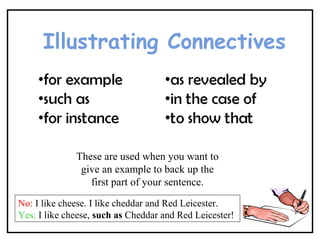

Recommended
Coordinating Conjunctions (FANBOYS)



Coordinating Conjunctions (FANBOYS)MYDA ANGELICA SUAN
Ėý
The document discusses conjunctions, which are words that join words, phrases, or clauses. There are two main types of conjunctions: coordinating conjunctions and subordinating conjunctions. Coordinating conjunctions include words like for, and, nor, but, or, yet, and so and are used to connect elements of equal value, such as words, phrases, and clauses. The document provides examples of conjunctions being used and provides a quiz to test the reader's knowledge of coordinating conjunctions.Grammar - Comma Use



Grammar - Comma UseSam Georgi
Ėý
This document provides rules for using commas correctly in sentences. It discusses six main rules:
1. Use commas to separate independent clauses joined by coordinating conjunctions.
2. Use commas in a series of three or more items.
3. Use commas after introductory phrases.
4. Use commas to set off nonessential clauses and phrases.
5. Use commas to set off a person's name when directly addressed.
6. Use a comma between two adjectives when they are interchangeable.
The document gives examples for each rule and exercises for the reader to practice applying the rules.Contractions



ContractionsBlessie Bustamante
Ėý
Contractions are abbreviated versions of words or phrases formed by either replacing missing letters with an apostrophe or compressing words without apostrophes. There are two types of contractions: those formed by shortening words and merging two words with an apostrophe like can't, shouldn't, he's, and don't, and those formed by compressing words without apostrophes like Mr., Dr., Prof., and Rev.Coordinating Conjunctions



Coordinating ConjunctionsRaisa Sarmiento
Ėý
The document discusses different conjunctions and how they are used to connect words, phrases, and clauses. It provides examples of using conjunctions like "and", "but", and "or" to join words, phrases, and independent clauses that are of equal value. It also distinguishes conjunctions that show addition ("and") from those that show contrast or limitation ("but", "yet").Possessive pronouns



Possessive pronounsSonia1942
Ėý
This document discusses possessive pronouns and how they show ownership. It explains that singular possessive pronouns include my, your, his, and her, while plural possessive pronouns are its, our, your, and their. Possessive pronouns can be used instead of possessive nouns to indicate who or what owns something.Grammar: Semicolons



Grammar: SemicolonsSam Georgi
Ėý
This document discusses the proper uses of semicolons in sentences. It provides 3 main rules: 1) Use semicolons to link two independent clauses that are closely related. 2) Also use semicolons to link independent clauses when there is a conjunctive adverb connecting them. 3) Use a semicolon to separate items in a series when one or more items contain commas. Examples are provided to illustrate each rule. Practice exercises then test the reader's understanding of when to correctly and incorrectly apply semicolons based on the rules.Run on sentences



Run on sentencesvlequire
Ėý
This document provides information about run-on sentences and how to identify and correct them. It defines two types of run-on sentences: fused sentences, which join two independent clauses with no punctuation, and comma splices, which join clauses with only a comma. Some ways to correct run-on sentences include adding a comma plus a coordinating conjunction, semicolon, period, or subordinating conjunction. Examples are given to demonstrate how to punctuate sentences properly and avoid run-ons.Apostrophe



Apostrophesaramblake
Ėý
The document discusses two main uses of apostrophes: forming contractions and showing possession. It provides examples of common contractions like don't and wouldn't which show where letters have been omitted. For possession, an apostrophe is added to the end of a noun to show it belongs to someone, like John's car. There are two rules for forming possessives - add only an apostrophe if the noun already ends in s, otherwise add 's. The document also briefly mentions a few other less common uses of apostrophes.Sentence structure powerpoint



Sentence structure powerpointRaja Mohan Krisnan
Ėý
This document provides information on how to vary sentence structure to make writing more interesting. It discusses using simple, compound, complex, and compound-complex sentences. Simple sentences contain one independent clause, while compound sentences contain two independent clauses joined with a conjunction. Complex sentences have one independent clause and one dependent clause. Compound-complex sentences contain two or more independent clauses and one or more dependent clauses. The document provides examples of each sentence type and guidelines for using commas with different clauses.Sentence structure



Sentence structureportoman
Ėý
This document discusses different types of sentences and common sentence structure issues. It describes simple, compound, complex, and compound-complex sentences. It also outlines issues like sentence fragments, run-on sentences, comma splices, choppy sentences, and stringy sentences. Examples are provided to illustrate each concept. The document encourages practicing different sentence structures and reviewing additional resources to improve writing skills.Time connectives



Time connectivesmecteam7
Ėý
The document discusses time connectives that can be used in expository writing to structure arguments and make the writing flow better. It provides examples of common time connectives like firstly, secondly, and finally. These specific connectives can be used to list ideas when writing arguments, helping to provide a structured view in three separate paragraphs. The document also includes a short example argument using these connectives to explain why animals should not be kept in cages.Prepositional Phrases



Prepositional PhrasesBonnie Smith
Ėý
The document discusses prepositions and prepositional phrases. It provides examples of common prepositions like "above", "beyond", and "in". It also gives examples of full sentences containing prepositional phrases like "above my head", "beyond the baseball field", and "in the pool". The document seeks to explain what a preposition is, its relationship to other words, and how a prepositional phrase is formed with a preposition and a noun or pronoun.Position of adverb



Position of adverbLenise Ngáŧc ThášĢo
Ėý
This document discusses adverbs and adverb phrases. It defines adverbs as words that describe verbs, adjectives, and other adverbs. Adverb phrases consist of an adverb plus any modifying adverbs or phrases. The document outlines five main grammatical functions of adverb phrases: adjective phrase modifier, adverb phrase modifier, verb phrase modifier, adverbial, and adjunct. It provides examples for each function and discusses the syntax of adverb phrases, including degree words, comparison, and coordination.Fanboys



FanboysEnglish Online Inc.
Ėý
This document discusses the FANBOYS conjunctions - for, and, nor, but, or, yet, and so. These conjunctions are called "coordinating conjunctions" because they connect words, phrases, and independent clauses. The document provides examples of how each conjunction is used and explains its meaning. It then shows the FANBOYS being used to improve a sample paragraph by joining related ideas and showing relationships between sentences.Prepositions



PrepositionsNines Picado
Ėý
The document discusses prepositions and provides examples of the prepositions "to", "up", and "off". It explains that prepositions show the relationship between two things and can indicate location, timing, or direction. Specifically, it states that "to" can indicate direction or purpose, "up" indicates direction away from the ground, and "off" indicates direction away from an original place. Examples are given for each preposition to illustrate its meaning and usage.Comparative/superlative of adverbs



Comparative/superlative of adverbsEsther Marvels
Ėý
This document discusses the comparative and superlative forms of adverbs. It explains that the comparative form compares two things and uses "-er" and the superlative compares three or more things and uses "-est". For regular adverbs ending in "-ly", the comparative uses "more" and the superlative uses "most". It provides examples of adverbs and their comparative and superlative forms. It also notes that some adverbs are irregular and lists those with their forms.Quotation Marks



Quotation Marksweberles
Ėý
The document provides guidelines for using quotation marks, including enclosing direct quotes but not indirect quotes. Direct quotes use quotation marks at the beginning and end and retain the speaker's exact words. Indirect quotes do not use quotation marks and rephrase the speaker's words. Punctuation like periods and commas go inside the closing quotation mark, while question marks and exclamation points go inside or outside depending on whether they are part of the quote. Dialogue in a story is indicated with quotation marks and a new paragraph each time the speaker changes. Several examples are provided to demonstrate proper punctuation and formatting of direct quotes.Compound sentences



Compound sentencesEnglish Online Inc.
Ėý
This document discusses compound sentences and their components. A compound sentence is composed of two independent clauses joined by a coordinating conjunction. The seven FANBOYS conjunctions - for, and, nor, but, or, yet, so - are used to connect independent clauses. Examples are provided of simple sentences being combined into compound sentences using various FANBOYS conjunctions. Attendees are given practice exercises to change pairs of simple sentences into single compound sentences. The document concludes by thanking attendees and announcing the next session.Conjunctions



ConjunctionsJburch297
Ėý
Conjunctions are words that connect other words or groups of words in a sentence. Common conjunctions include and, but, and or. And joins together words or phrases, but shows a difference, and or shows a choice between two options.Conditional Sentences



Conditional SentencesIES Rosario de AcuÃąa
Ėý
There are three main types of conditional patterns in conditional sentences: Pattern A is used for probable conditions, Pattern B is used for improbable conditions, and Pattern C is used for imaginary conditions. Pattern A uses present tense in the if-clause and future tense in the main clause. Pattern B uses past tense in the if-clause and would/should + verb in the main clause. Pattern C uses past perfect in the if-clause and perfect conditional ("would have" + past participle) in the main clause.The perfect tenses



The perfect tensesAlgemNess MG
Ėý
The document discusses the perfect tenses in English - the present perfect, past perfect, and future perfect. It provides examples of how to form each tense using auxiliary verbs and past participles. It also explains the uses of each tense, such as denoting completed actions connected to the present (present perfect), actions completed before a past time (past perfect), and actions that will be completed before a future time (future perfect). Exercises are provided to practice forming sentences using these tenses.Correlative Conjunctions



Correlative ConjunctionsMariano Marcos State University - College of Teacher Education (CTE)
Ėý
Hello grammarians! This powerpoint presentation will present the most popular correlative conjunctions as well as the most common mistakes committed by the English speakers and writers.Relative pronouns



Relative pronounsDanitza Lazcano Flores
Ėý
The document discusses relative clauses and how they are used to provide additional information about a person, place, or thing without starting a new sentence. It explains that relative clauses combine two sentences using a relative pronoun such as who, which, that, or whose. Examples are provided to illustrate how to form relative clauses using these relative pronouns, including replacing the repeated word with the pronoun in the second part of the sentence. Common relative pronouns are defined along with their uses. An exercise is included for the reader to practice completing sentences with the appropriate relative pronoun.Connectives



ConnectivesMariela Pineda
Ėý
The document discusses how to use connectives to make more interesting and effective sentences. It provides examples of connectives like however, although, and, because, but, furthermore, meanwhile, and so. It shows how to connect two simple sentences using connectives and emphasizes using commas. Finally, it provides examples of sentences using different connectives and encourages the reader to practice using connectives to tell stories and play games.Infinitives



InfinitivesYoushaib Alam
Ėý
This file deals with the basic concepts regarding infinitives, its types and usage of infinitives in different situations. This file discusses the basic definition of infinitives briefly. It deals with the identification of infinitives. "Full infinitive", "Bare infinitive" and "Anaphoric to" are the basic types that are discussed in this presentation. Interrogative pronouns



Interrogative pronounsMaestrang Techy
Ėý
- Interrogative pronouns are used to ask questions to gain information and include who, whom, what, whose, and which.
- Who refers to people and functions as a subject. Whom also refers to people but functions as an object. Whose expresses belonging or possession.
- What refers to things. Which is used to ask between options or choices.
- The passage provides examples of sentences using each interrogative pronoun to demonstrate their functions.Compound subjects and compound predicates



Compound subjects and compound predicatesNevineAziz
Ėý
This document discusses compound subjects and predicates. It provides examples of sentences containing compound subjects, like "Jack and Jill went up the hill" containing the compound subject "Jack and Jill". It also gives examples of sentences with compound predicates, such as "Eric plays football and swims on the swim team" containing the compound predicate "plays football and swims". The document asks the reader to combine sentences to form compound subjects and predicates.Persuasive texts presentation



Persuasive texts presentationLisa
Ėý
A persuasive text aims to convince readers by appealing to their emotions and ability to reason. Some common types of persuasive texts include speeches, books, and essays that try to get readers to agree with a point of view. Writers use techniques like facts, repetition, and strong language to persuade. They may repeat phrases to draw attention and create rhythm, use facts to support their arguments, and choose strong words to effectively make their point. The goal is for the writing to reach readers emotionally and get them to believe something.Comprehensive Guide to Antibiotics & Beta-Lactam Antibiotics.pptx



Comprehensive Guide to Antibiotics & Beta-Lactam Antibiotics.pptxSamruddhi Khonde
Ėý
ðĒ Comprehensive Guide to Antibiotics & Beta-Lactam Antibiotics
ðŽ Antibiotics have revolutionized medicine, playing a crucial role in combating bacterial infections. Among them, Beta-Lactam antibiotics remain the most widely used class due to their effectiveness against Gram-positive and Gram-negative bacteria. This guide provides a detailed overview of their history, classification, chemical structures, mode of action, resistance mechanisms, SAR, and clinical applications.
ð What Youâll Learn in This Presentation
â
History & Evolution of Antibiotics
â
Cell Wall Structure of Gram-Positive & Gram-Negative Bacteria
â
Beta-Lactam Antibiotics: Classification & Subtypes
â
Penicillins, Cephalosporins, Carbapenems & Monobactams
â
Mode of Action (MOA) & Structure-Activity Relationship (SAR)
â
Beta-Lactamase Inhibitors & Resistance Mechanisms
â
Clinical Applications & Challenges.
ð Why You Should Check This Out?
Essential for pharmacy, medical & life sciences students.
Provides insights into antibiotic resistance & pharmaceutical trends.
Useful for healthcare professionals & researchers in drug discovery.
ð Swipe through & explore the world of antibiotics today!
ð Like, Share & Follow for more in-depth pharma insights!More Related Content
What's hot (20)
Sentence structure powerpoint



Sentence structure powerpointRaja Mohan Krisnan
Ėý
This document provides information on how to vary sentence structure to make writing more interesting. It discusses using simple, compound, complex, and compound-complex sentences. Simple sentences contain one independent clause, while compound sentences contain two independent clauses joined with a conjunction. Complex sentences have one independent clause and one dependent clause. Compound-complex sentences contain two or more independent clauses and one or more dependent clauses. The document provides examples of each sentence type and guidelines for using commas with different clauses.Sentence structure



Sentence structureportoman
Ėý
This document discusses different types of sentences and common sentence structure issues. It describes simple, compound, complex, and compound-complex sentences. It also outlines issues like sentence fragments, run-on sentences, comma splices, choppy sentences, and stringy sentences. Examples are provided to illustrate each concept. The document encourages practicing different sentence structures and reviewing additional resources to improve writing skills.Time connectives



Time connectivesmecteam7
Ėý
The document discusses time connectives that can be used in expository writing to structure arguments and make the writing flow better. It provides examples of common time connectives like firstly, secondly, and finally. These specific connectives can be used to list ideas when writing arguments, helping to provide a structured view in three separate paragraphs. The document also includes a short example argument using these connectives to explain why animals should not be kept in cages.Prepositional Phrases



Prepositional PhrasesBonnie Smith
Ėý
The document discusses prepositions and prepositional phrases. It provides examples of common prepositions like "above", "beyond", and "in". It also gives examples of full sentences containing prepositional phrases like "above my head", "beyond the baseball field", and "in the pool". The document seeks to explain what a preposition is, its relationship to other words, and how a prepositional phrase is formed with a preposition and a noun or pronoun.Position of adverb



Position of adverbLenise Ngáŧc ThášĢo
Ėý
This document discusses adverbs and adverb phrases. It defines adverbs as words that describe verbs, adjectives, and other adverbs. Adverb phrases consist of an adverb plus any modifying adverbs or phrases. The document outlines five main grammatical functions of adverb phrases: adjective phrase modifier, adverb phrase modifier, verb phrase modifier, adverbial, and adjunct. It provides examples for each function and discusses the syntax of adverb phrases, including degree words, comparison, and coordination.Fanboys



FanboysEnglish Online Inc.
Ėý
This document discusses the FANBOYS conjunctions - for, and, nor, but, or, yet, and so. These conjunctions are called "coordinating conjunctions" because they connect words, phrases, and independent clauses. The document provides examples of how each conjunction is used and explains its meaning. It then shows the FANBOYS being used to improve a sample paragraph by joining related ideas and showing relationships between sentences.Prepositions



PrepositionsNines Picado
Ėý
The document discusses prepositions and provides examples of the prepositions "to", "up", and "off". It explains that prepositions show the relationship between two things and can indicate location, timing, or direction. Specifically, it states that "to" can indicate direction or purpose, "up" indicates direction away from the ground, and "off" indicates direction away from an original place. Examples are given for each preposition to illustrate its meaning and usage.Comparative/superlative of adverbs



Comparative/superlative of adverbsEsther Marvels
Ėý
This document discusses the comparative and superlative forms of adverbs. It explains that the comparative form compares two things and uses "-er" and the superlative compares three or more things and uses "-est". For regular adverbs ending in "-ly", the comparative uses "more" and the superlative uses "most". It provides examples of adverbs and their comparative and superlative forms. It also notes that some adverbs are irregular and lists those with their forms.Quotation Marks



Quotation Marksweberles
Ėý
The document provides guidelines for using quotation marks, including enclosing direct quotes but not indirect quotes. Direct quotes use quotation marks at the beginning and end and retain the speaker's exact words. Indirect quotes do not use quotation marks and rephrase the speaker's words. Punctuation like periods and commas go inside the closing quotation mark, while question marks and exclamation points go inside or outside depending on whether they are part of the quote. Dialogue in a story is indicated with quotation marks and a new paragraph each time the speaker changes. Several examples are provided to demonstrate proper punctuation and formatting of direct quotes.Compound sentences



Compound sentencesEnglish Online Inc.
Ėý
This document discusses compound sentences and their components. A compound sentence is composed of two independent clauses joined by a coordinating conjunction. The seven FANBOYS conjunctions - for, and, nor, but, or, yet, so - are used to connect independent clauses. Examples are provided of simple sentences being combined into compound sentences using various FANBOYS conjunctions. Attendees are given practice exercises to change pairs of simple sentences into single compound sentences. The document concludes by thanking attendees and announcing the next session.Conjunctions



ConjunctionsJburch297
Ėý
Conjunctions are words that connect other words or groups of words in a sentence. Common conjunctions include and, but, and or. And joins together words or phrases, but shows a difference, and or shows a choice between two options.Conditional Sentences



Conditional SentencesIES Rosario de AcuÃąa
Ėý
There are three main types of conditional patterns in conditional sentences: Pattern A is used for probable conditions, Pattern B is used for improbable conditions, and Pattern C is used for imaginary conditions. Pattern A uses present tense in the if-clause and future tense in the main clause. Pattern B uses past tense in the if-clause and would/should + verb in the main clause. Pattern C uses past perfect in the if-clause and perfect conditional ("would have" + past participle) in the main clause.The perfect tenses



The perfect tensesAlgemNess MG
Ėý
The document discusses the perfect tenses in English - the present perfect, past perfect, and future perfect. It provides examples of how to form each tense using auxiliary verbs and past participles. It also explains the uses of each tense, such as denoting completed actions connected to the present (present perfect), actions completed before a past time (past perfect), and actions that will be completed before a future time (future perfect). Exercises are provided to practice forming sentences using these tenses.Correlative Conjunctions



Correlative ConjunctionsMariano Marcos State University - College of Teacher Education (CTE)
Ėý
Hello grammarians! This powerpoint presentation will present the most popular correlative conjunctions as well as the most common mistakes committed by the English speakers and writers.Relative pronouns



Relative pronounsDanitza Lazcano Flores
Ėý
The document discusses relative clauses and how they are used to provide additional information about a person, place, or thing without starting a new sentence. It explains that relative clauses combine two sentences using a relative pronoun such as who, which, that, or whose. Examples are provided to illustrate how to form relative clauses using these relative pronouns, including replacing the repeated word with the pronoun in the second part of the sentence. Common relative pronouns are defined along with their uses. An exercise is included for the reader to practice completing sentences with the appropriate relative pronoun.Connectives



ConnectivesMariela Pineda
Ėý
The document discusses how to use connectives to make more interesting and effective sentences. It provides examples of connectives like however, although, and, because, but, furthermore, meanwhile, and so. It shows how to connect two simple sentences using connectives and emphasizes using commas. Finally, it provides examples of sentences using different connectives and encourages the reader to practice using connectives to tell stories and play games.Infinitives



InfinitivesYoushaib Alam
Ėý
This file deals with the basic concepts regarding infinitives, its types and usage of infinitives in different situations. This file discusses the basic definition of infinitives briefly. It deals with the identification of infinitives. "Full infinitive", "Bare infinitive" and "Anaphoric to" are the basic types that are discussed in this presentation. Interrogative pronouns



Interrogative pronounsMaestrang Techy
Ėý
- Interrogative pronouns are used to ask questions to gain information and include who, whom, what, whose, and which.
- Who refers to people and functions as a subject. Whom also refers to people but functions as an object. Whose expresses belonging or possession.
- What refers to things. Which is used to ask between options or choices.
- The passage provides examples of sentences using each interrogative pronoun to demonstrate their functions.Compound subjects and compound predicates



Compound subjects and compound predicatesNevineAziz
Ėý
This document discusses compound subjects and predicates. It provides examples of sentences containing compound subjects, like "Jack and Jill went up the hill" containing the compound subject "Jack and Jill". It also gives examples of sentences with compound predicates, such as "Eric plays football and swims on the swim team" containing the compound predicate "plays football and swims". The document asks the reader to combine sentences to form compound subjects and predicates.Persuasive texts presentation



Persuasive texts presentationLisa
Ėý
A persuasive text aims to convince readers by appealing to their emotions and ability to reason. Some common types of persuasive texts include speeches, books, and essays that try to get readers to agree with a point of view. Writers use techniques like facts, repetition, and strong language to persuade. They may repeat phrases to draw attention and create rhythm, use facts to support their arguments, and choose strong words to effectively make their point. The goal is for the writing to reach readers emotionally and get them to believe something.Recently uploaded (20)
Comprehensive Guide to Antibiotics & Beta-Lactam Antibiotics.pptx



Comprehensive Guide to Antibiotics & Beta-Lactam Antibiotics.pptxSamruddhi Khonde
Ėý
ðĒ Comprehensive Guide to Antibiotics & Beta-Lactam Antibiotics
ðŽ Antibiotics have revolutionized medicine, playing a crucial role in combating bacterial infections. Among them, Beta-Lactam antibiotics remain the most widely used class due to their effectiveness against Gram-positive and Gram-negative bacteria. This guide provides a detailed overview of their history, classification, chemical structures, mode of action, resistance mechanisms, SAR, and clinical applications.
ð What Youâll Learn in This Presentation
â
History & Evolution of Antibiotics
â
Cell Wall Structure of Gram-Positive & Gram-Negative Bacteria
â
Beta-Lactam Antibiotics: Classification & Subtypes
â
Penicillins, Cephalosporins, Carbapenems & Monobactams
â
Mode of Action (MOA) & Structure-Activity Relationship (SAR)
â
Beta-Lactamase Inhibitors & Resistance Mechanisms
â
Clinical Applications & Challenges.
ð Why You Should Check This Out?
Essential for pharmacy, medical & life sciences students.
Provides insights into antibiotic resistance & pharmaceutical trends.
Useful for healthcare professionals & researchers in drug discovery.
ð Swipe through & explore the world of antibiotics today!
ð Like, Share & Follow for more in-depth pharma insights!Year 10 The Senior Phase Session 3 Term 1.pptx



Year 10 The Senior Phase Session 3 Term 1.pptxmansk2
Ėý
Year 10 The Senior Phase Session 3 Term 1.pptxDot NET Core Interview Questions PDF By ScholarHat



Dot NET Core Interview Questions PDF By ScholarHatScholarhat
Ėý
Dot NET Core Interview Questions PDF By ScholarHatMastering Soft Tissue Therapy & Sports Taping



Mastering Soft Tissue Therapy & Sports TapingKusal Goonewardena
Ėý
Mastering Soft Tissue Therapy & Sports Taping: Pathway to Sports Medicine Excellence
This presentation was delivered in Colombo, Sri Lanka, at the Institute of Sports Medicine to an audience of sports physiotherapists, exercise scientists, athletic trainers, and healthcare professionals. Led by Kusal Goonewardena (PhD Candidate - Muscle Fatigue, APA Titled Sports & Exercise Physiotherapist) and Gayath Jayasinghe (Sports Scientist), the session provided comprehensive training on soft tissue assessment, treatment techniques, and essential sports taping methods.
Key topics covered:
â
Soft Tissue Therapy â The science behind muscle, fascia, and joint assessment for optimal treatment outcomes.
â
Sports Taping Techniques â Practical applications for injury prevention and rehabilitation, including ankle, knee, shoulder, thoracic, and cervical spine taping.
â
Sports Trainer Level 1 Course by Sports Medicine Australia â A gateway to professional development, career opportunities, and working in Australia.
This training mirrors the Elite Akademy Sports Medicine standards, ensuring evidence-based approaches to injury management and athlete care.
If you are a sports professional looking to enhance your clinical skills and open doors to global opportunities, this presentation is for you.Azure Data Engineer Interview Questions By ScholarHat



Azure Data Engineer Interview Questions By ScholarHatScholarhat
Ėý
Azure Data Engineer Interview Questions By ScholarHatIntellectual Honesty & Research Integrity.pptx



Intellectual Honesty & Research Integrity.pptxNidhiSharma495177
Ėý
Research Publication & Ethics contains a chapter on Intellectual Honesty and Research Integrity.
Different case studies of intellectual dishonesty and integrity were discussed.Effective Product Variant Management in Odoo 18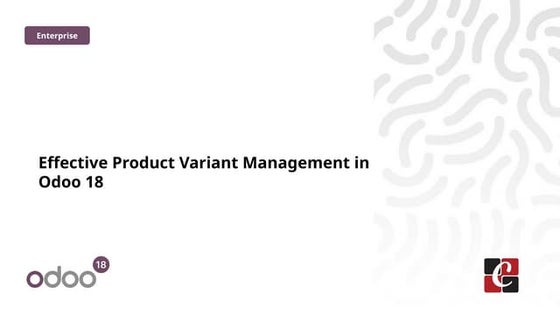



Effective Product Variant Management in Odoo 18Celine George
Ėý
In this slide weâll discuss on the effective product variant management in Odoo 18. Odoo concentrates on managing product variations and offers a distinct area for doing so. Product variants provide unique characteristics like size and color to single products, which can be managed at the product template level for all attributes and variants or at the variant level for individual variants.Hannah Borhan and Pietro Gagliardi OECD present 'From classroom to community ...



Hannah Borhan and Pietro Gagliardi OECD present 'From classroom to community ...EduSkills OECD
Ėý
Hannah Borhan, Research Assistant, OECD Education and Skills Directorate and Pietro Gagliardi, Policy Analyst, OECD Public Governance Directorate present at the OECD webinar 'From classroom to community engagement: Promoting active citizenship among young people" on 25 February 2025. You can find the recording of the webinar on the website https://oecdedutoday.com/webinars/
Functional Muscle Testing of Facial Muscles.pdf



Functional Muscle Testing of Facial Muscles.pdfSamarHosni3
Ėý
Functional Muscle Testing of Facial Muscles.pdfHow to create security group category in Odoo 17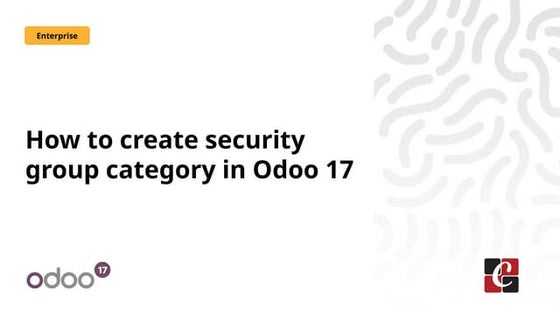



How to create security group category in Odoo 17Celine George
Ėý
This slide will represent the creation of security group category in odoo 17. Security groups are essential for managing user access and permissions across different modules. Creating a security group category helps to organize related user groups and streamline permission settings within a specific module or functionality.ASP.NET Web API Interview Questions By Scholarhat



ASP.NET Web API Interview Questions By ScholarhatScholarhat
Ėý
ASP.NET Web API Interview Questions By ScholarhatUnit 1 Computer Hardware for Educational Computing.pptx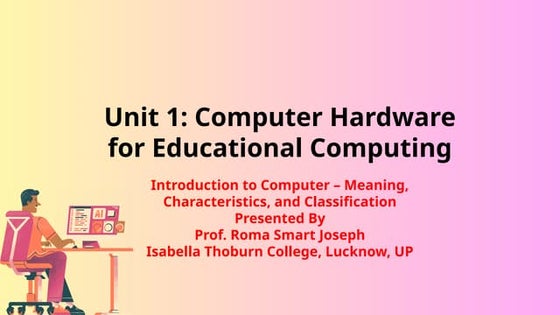



Unit 1 Computer Hardware for Educational Computing.pptxRomaSmart1
Ėý
Computers have revolutionized various sectors, including education, by enhancing learning experiences and making information more accessible. This presentation, "Computer Hardware for Educational Computing," introduces the fundamental aspects of computers, including their definition, characteristics, classification, and significance in the educational domain. Understanding these concepts helps educators and students leverage technology for more effective learning.How to Configure Recurring Revenue in Odoo 17 CRM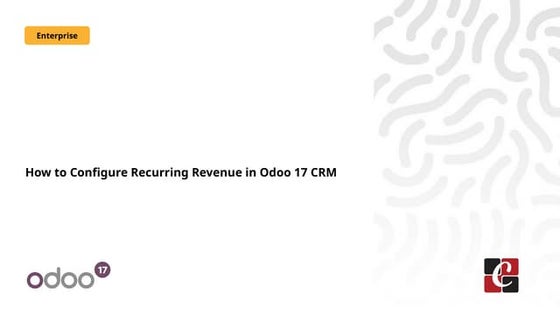



How to Configure Recurring Revenue in Odoo 17 CRMCeline George
Ėý
This slide will represent how to configure Recurring revenue. Recurring revenue are the income generated at a particular interval. Typically, the interval can be monthly, yearly, or we can customize the intervals for a product or service based on its subscription or contract. Full-Stack .NET Developer Interview Questions PDF By ScholarHat



Full-Stack .NET Developer Interview Questions PDF By ScholarHatScholarhat
Ėý
Full-Stack .NET Developer Interview Questions PDF By ScholarHatOral exam Kenneth Bech - What is the meaning of strategic fit?



Oral exam Kenneth Bech - What is the meaning of strategic fit?MIPLM
Ėý
Presentation of the CEIPI DU IPBA oral exam of Kenneth Bech - What is the meaning of strategic fit? One Click RFQ Cancellation in Odoo 18 - Odoo šÝšÝßĢs



One Click RFQ Cancellation in Odoo 18 - Odoo šÝšÝßĢsCeline George
Ėý
In this slide, weâll discuss the one click RFQ Cancellation in odoo 18. One-Click RFQ Cancellation in Odoo 18 is a feature that allows users to quickly and easily cancel Request for Quotations (RFQs) with a single click.Types of connectives
- 1. Adding Connectives: These are used when you want to add ideas together that agree with each other or are about the same thing. No: I like cheese. I like sausages. Yes: I like cheese, I also like sausages.
- 2. Sequencing Connectives These are used when you want to list ideas in a certain order. No: I cut the cheese. I cooked sausages. Yes: I cut the cheese, finally I cooked the sausages.
- 3. Emphasising Connectives These are used when you want to stress a point as being very important. No: I like cheese. I really like cheddar. Yes: I like cheese, in particular, cheddar.
- 4. Comparing Connectives These are used when you want to compare ideas that are similar or the same as each other. No: I like cheese. I like sausages. Yes: I like cheese, equally I like sausages.
- 5. Cause and Effect Connectives These are used when you want the second part of your sentence to help explain the first part. The second part happens as a result of the first. No: I like cheese. I ate the cheese. Yes: I like cheese, therefore I ate the cheese!
- 6. Qualifying Connectives These are used when the first idea in your sentence relies on the second part happening. No: Iâll cut the cheese. You get the knife. Yes: Iâll cut cheese, as long as you get the knife.
- 7. Illustrating Connectives These are used when you want to give an example to back up the first part of your sentence. No: I like cheese. I like cheddar and Red Leicester. Yes: I like cheese, such as Cheddar and Red Leicester!
- 8. Contrasting Connectives These are used when you have two ideas in your sentence that do not agree with each other. No: I like cheese. I do not like tomatoes. Yes: I like cheese, on the other hand, I do not like tomatoes.



